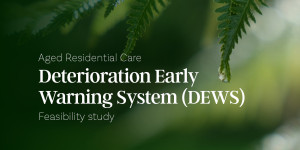About DEWS
The Deterioration Early Warning System (DEWS) is designed to support health care staff working in aged residential care to identify and respond to a person who could be acutely unwell. It works by using age-specific clinical indicators and measuring a person’s vital signs to identify and respond to possible acute deterioration.
DEWS provides a structured framework for assessing residents. It combines specific clinical indicators with vital sign measures to assess deterioration and clinical urgency, and to respond using a standardised escalation pathway.
DEWS was co-designed with aged residential care providers and tested in real-world conditions. It is tailored to the unique needs of aged residential care, with tools to support health care assistants, registered nurses and clinical leaders.
Tools to apply DEWS
There are three integrated tools to enable staff to apply DEWS.
- Quick-DEWS – for health care assistants to recognise and report early changes
- DEWS-RN – for registered nurses to conduct structured assessments and escalate care
- SBARR-DEWS – a critical thinking and communication tool to standardise handover to primary or secondary care.
There are education resources, a measurement framework and options to digitise the tools into a resident management system to support implementation throughout aged residential care facilities.
Why DEWS matters
Research shows older adults living in aged residential care (residents) often experience atypical patterns of acute deterioration that are not well captured by early warning tools used in hospitals. Residents often show subtle signs of deterioration that can be missed without structured observation and communication.
DEWS enables health care assistants to observe day-to-day indicators of acute deterioration, triggering a structured nurse assessment and a standardised escalation pathway.
A feasibility study in aged residential care found that DEWS:
- helps aged residential care staff promptly identify and respond to acute deterioration
- supports critical thinking
- improves communication across staff, whānau and primary health care
- supports clinical accountability.
Importantly, it was found to empower health care assistants and support newly qualified staff, while ensuring residents receive timely care in their home.
Video: An introduction to the Deterioration Early Warning System
This video is an introduction to DEWS and its development. It shows how the three tools work together to support aged residential care staff to identify and respond to acute deterioration in older adults.
Implementing DEWS for aged residential care facilities
 In 2024, five aged residential care facilities participated in a feasibility study to test DEWS. The use of DEWS was recommended by participants for the aged residential care sector. Participants also strongly recommended that DEWS be digitised, to enable integration into existing resident management systems throughout the aged residential care sector.
In 2024, five aged residential care facilities participated in a feasibility study to test DEWS. The use of DEWS was recommended by participants for the aged residential care sector. Participants also strongly recommended that DEWS be digitised, to enable integration into existing resident management systems throughout the aged residential care sector.
Read the feasibility study report
How providers can implement DEWS
We are inviting aged residential care facilities to register their interest to participate in implementing DEWS. There is a phased national roll out to accommodate facility readiness and digital capability.
- Phase one involves facilities ready to implement paper-based DEWS or using resident management system (RMS) platforms with DEWS embedded (eg, VCare version 6.2 and Hercules Health).
- Phase two and onwards involves the implementation of digital DEWS in facilities as more RMS platforms integrate the tools.
